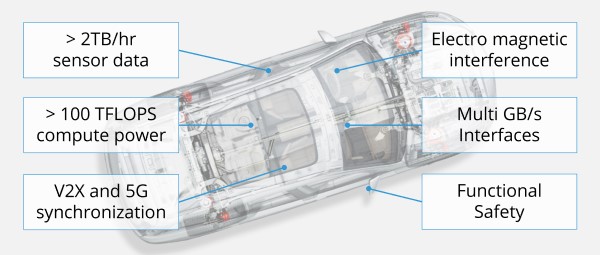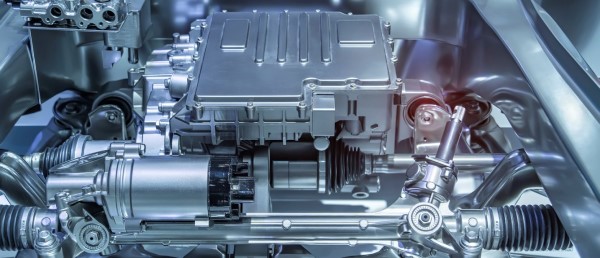Four Megatrends in the Automotive Industry
The automotive industry is currently undergoing a massive transformation, fueled by four major trends that are shaping the future of transportation: electrification, shared automobile models, active safety systems, and driving automation. These trends have a major impact on the way vehicles are being designed. The market for automotive electrical/electronic components and software to serve these macrotrends is expected to reach $450 billion by 2030, which is more than double the growth of the overall automotive market. As we navigate these changes, one key component remains critical to the safe, reliable operation of automotive systems: precision timing. In the face of today's challenges, precision timing technologies are playing a vital role in sensing, communications, and computing within automotive systems.

Timing is critical to sensing, communication, and compute
1. Electrification: Revolutionizing Drivetrain Technology
The electric vehicle (EV) market will continue to accelerate as automakers phase out internal combustion engine models. Lower battery costs, longer battery life, improved charging capabilities and extended EV driving range will further speed vehicle electrification.

With today’s surge in EVs, there's a growing need for more advanced and complex electronic automotive systems, requiring numerous chips. While these systems enable cleaner and more efficient transportation, they also pose design challenges. These dense electronic systems must cope with increasing electromagnetic interference (EMI) due to the higher currents in the vehicle, which can disrupt the operation of electronic devices. Robust timing products play a vital role in clocking and synchronizing complex automotive electronics, enabling EVs to operate reliably, even in noisy and demanding environments.
2. Shared Automobile Usage: Driving Reliability Needs
From ridesharing to car sharing, the rise of shared automobile usage models – which keep vehicles in operation up to 90% of the time compared to single-user vehicles – calls for highly reliable automotive systems. Frequent on and off cycles, along with increased wear and tear, require robust components that can withstand elevated duty cycles. Automotive operating environments are inherently harsh, with high ambient temperatures, high vibration, and mechanical shock. By keeping vehicles on the road for longer periods of time, shared usage models place even higher demands on the reliability of automotive electronics.

Today’s cars use up to 70 timing devices. That number is growing as cars adopt smarter technologies and integrate more sensors. Oscillators provide critical clocking functions for a wide array of digital systems – including electronic control units (ECUs), advanced driver assistance systems (ADAS), in-vehicle networks, infotainment, and other subsystems. The need for higher reliability and resilience in timing devices is increasingly critical to keep shared vehicles operating safely and securely.
3. Safety: From Passive to Active
A more active approach to automotive safety is being spurred by regulations like ISO 26262 for functional safety and SOTIF (Safety of the Intended Functionality) to ensure intended performance over a range of demanding conditions. While these safety standards increase the complexity of automotive designs, they are essential for saving lives and achieving the goals of Vision Zero, a strategy to eliminate traffic fatalities and severe injuries.

As automotive safety continues to evolve, precision timing plays a key role in maintaining functional safety as the industry shifts from passive to active safety systems. Vehicles equipped with ADAS computers and sensor-laden safety systems require fast, reliable communications across the car’s Ethernet backbone and over wireless networks. Component failure is not an option in safety-critical automotive systems. Timing devices must be reliable and accurate to synchronize high volumes of sensor data, effectively manage multi GB/s interfaces, and ensure seamless communications between internal and external vehicle systems, including emerging vehicle-to-everything (V2X) connectivity.
4. Driving Automation: Managing the Data Explosion
Autonomous driving continues to be one of most significant automotive trends. While the industry is still at level 2 and level 3, driving automation is progressing at a rapid pace and level 4 is fast approaching. As electronic systems become more complex and more sensors are added to achieve automation, vehicles can generate more than 20TB of data per hour. This data deluge requires seamless communications and advanced processing capabilities with up to 100 TFLOPS of compute power.

Precision timing is essential in managing this vast amount of data. Timing devices must continuously synchronize high-speed data transfers from various sensors to ADAS computers and ECUs. Since they are critical for active safety systems and autonomous driving capabilities, automotive timing devices must offer ultra-low jitter, exceptional stability, and reliable operation in the most demanding environmental conditions. Without reliable precision timing, the advanced capabilities promised by automation simply wouldn't be possible.
A Timely Transformation
Tremendous innovations in electrification, car sharing, active safety and autonomous driving technologies are reshaping the future of the automotive market. Precision timing components are a critical part of this future. Smart, connected cars and safety-critical systems require timing components designed to deliver the utmost in reliability, stability, and performance. By shifting from legacy quartz technology to precision timing based on microelectromechanical system (MEMS) technology, automakers are making a strategic investment in safer, more reliable automotive system designs. SiTime's MEMS-based precision timing solutions support the automotive industry's continuous evolution, making vehicles safer, more efficient, and more connected.
Related Blogs
The Growing Complexity of Automotive System Timing
It’s All About Precision Timing: 7 Top Tech Trends for 2023
The future of E/E architecture and its impact on clocks